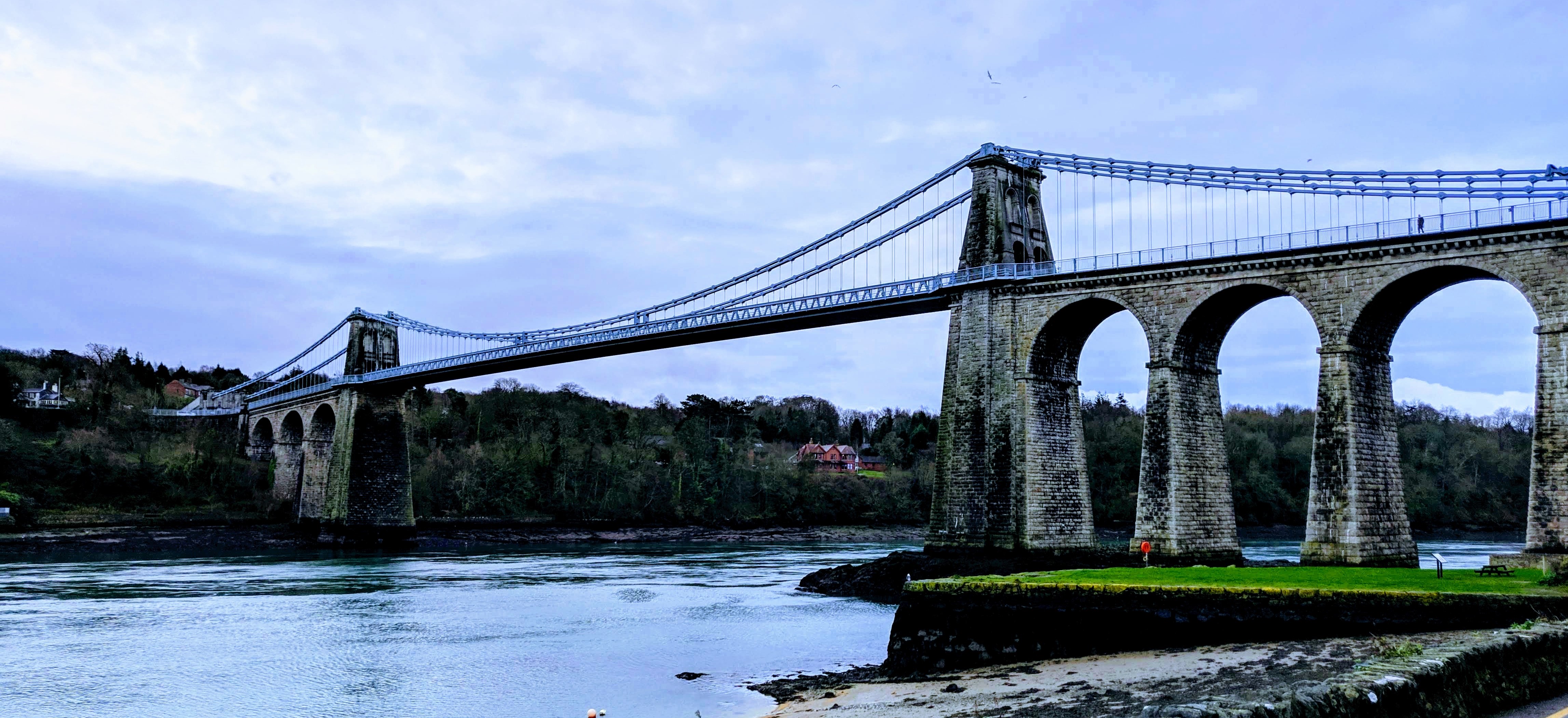Going the extra mile to extend the lifespan of the Menai Suspension Bridge
[edit] Introduction
Luke Fisher, sector lead for Bridges & Structures at Spencer Group, the principal contractor on the Menai Suspension Bridge remedial works, provides a fascinating overview of the project.
[edit] Overview of project
It’s a real privilege to be involved in this project and be given the opportunity to work on Thomas Telford’s world-famous and historically significant major structure. We were awarded the project as the principal contractor to replace 73 concrete footway panels on the approach spans which were found to be defective and in need of replacement as a result of a principal inspection carried out in 2020.
Due to our expertise in this field, having recently been awarded a contract to fully dismantle, refurbish and re-build the Union Chain Bridge in Northumberland, we were awarded a contract initially to provide pre-construction advice to assist with development of methodologies for footway panel replacement on the Menai Suspension Bridge. During this period, we built up an excellent relationship with the client’s project team, which subsequently led to us being awarded the construction phase on the project, which we began on-site in 2021.
[edit] How we decided on three key construction methods
During the early contractor involvement phase in mid- to late-2020, we were requested to review proposed construction methods of the footway panels and provide options for how the panels could be removed and replaced safely. Particular emphasis was placed on designing construction methodologies to eliminate discharge of any debris as a result of the construction operations into the environmentally protected Menai Strait below.
Three key elements emerged as a result of our early involvement:
[edit] 1. A change in how the panels were proposed to be constructed.
Initially, in-situ poured concrete was thought to be the only option due to the varying panel sizes which increase in width along the length of the bridge.
The panels are supported on a narrow rebate on three edges and historical information for panel geometry was very limited. We did, however, believe that by carrying out accurate surveys of each individual panel in advance, pre-casting off-site in a factory environment would be possible. This would not only improve the quality of the panels but also eliminate many of the environmental hazards associated with in-situ poured concrete on site above the Menai Strait.
[edit] 2. Proposal of a lifting and traversing method for panel replacement, based on our current methodologies utilised for footway panel refurbishment on Erskine Bridge.
The proposal was the use of a lifting A-frame arrangement sat within the footway envelope, allowing the footway replacement operation to be carried out in one sequence, minimising the time when a panel is removed and minimising interface with the carriageway.
[edit] 3. Proposal for a bespoke debris capture system below the panel location, that slides along with the construction operation above.
The debris catch system would be fully sealed to the bridge, complete with solid netting to ensure debris is retained within the worksite and not discharged into the environment below.
[edit] Achieving quality and accuracy during the construction phase
By February 2021, the designs were approved, and we were carrying out the detailed surveys of each individual panel to allow construction to begin in batches once measured. Every panel on the west elevation was out of square, and no two panels were the same. Each panel was custom made to suit to very tight tolerances, ensuring the designer’s requirements were achieved.
This element is a challenging part of the project, which relies on accurate surveys and manufacturing of the concrete to ensure the specification is met. Quality of the construction and installation has been our number one priority to ensure the panels achieve their 50-year design life and prolong the life of this wonderful structure.
[edit] Unique opportunity for our apprentices
As a founder partner of the Ron Dearing UTC in Hull, Spencer Group took on 10 civil engineering apprentices in 2020, who are on rotation within various business functions, learning about engineering design, construction, project management and many more.
With the award of this project, we have given one of our apprentices, Alistair Sceats, a unique and fantastic opportunity to be involved in this project based on site for the duration of the works. Alistair has been involved in all elements of the project, working with our site manager to assist with the site surveys, QA checks, panel installations and general project management activities.
In addition to Alistair, some of our other apprentices will visit the site throughout the project at keys milestones to be directly involved in some of the work we are carrying out on the bridge. Development of the next generation of civil engineers is really important to us as a business, and we wanted to make sure this rare opportunity of working on Telford’s iconic structure was one not to be missed.
I was fortunate enough to work on Brunel’s Clifton Suspension Bridge 15 years ago as an apprentice myself, installing the tower access cradles which was an experience I’ll never forget. It’s great to be able to give our apprentices the opportunity to be involved in something similar, which I’m sure will be an experience that will stay with them throughout their career.
This article originally appeared on The Civil Engineer Blog portion of the ICE website. It was written by Luke Fisher, sector lead for Bridges & Structures at Spencer Group and was published on 18 March 2021.
--The Institution of Civil Engineers
[edit] Related articles on Designing Buildings Wiki
IHBC NewsBlog
IHBC Membership Journal Context - Latest Issue on 'Hadrian's Wall' Published
The issue includes takes on the wall 'end-to-end' including 'the man who saved it'.
Heritage Building Retrofit Toolkit developed by City of London and Purcell
The toolkit is designed to provide clear and actionable guidance for owners, occupiers and caretakers of historic and listed buildings.
70 countries sign Declaration de Chaillot at Buildings & Climate Global Forum
The declaration is a foundational document enabling progress towards a ‘rapid, fair, and effective transition of the buildings sector’
Bookings open for IHBC Annual School 12-15 June 2024
Theme: Place and Building Care - Finance, Policy and People in Conservation Practice
Rare Sliding Canal Bridge in the UK gets a Major Update
A moveable rail bridge over the Stainforth and Keadby Canal in the Midlands in England has been completely overhauled.
'Restoration and Renewal: Developing the strategic case' Published
The House of Commons Library has published the research briefing, outlining the different options for the Palace of Westminster.
Brum’s Broad Street skyscraper plans approved with unusual rule for residents
A report by a council officer says that the development would provide for a mix of accommodation in a ‘high quality, secure environment...
English Housing Survey 2022 to 2023
Initial findings from the English Housing Survey 2022 to 2023 have been published.
Audit Wales research report: Sustainable development?
A new report from Audit Wales examines how Welsh Councils are supporting repurposing and regeneration of vacant properties and brownfield sites.
New Guidance Launched on ‘Understanding Special Historic Interest in Listing’
Historic England (HE) has published this guidance to help people better understand special historic interest, one of the two main criteria used to decide whether a building can be listed or not.


















